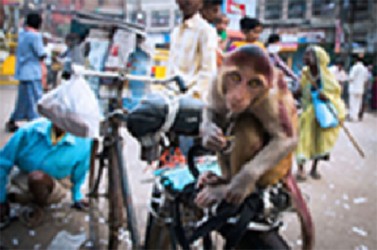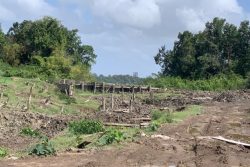VARANASI, India (Reuters) – As India launches an $18 billion plan to spread the information revolution to its provinces, the problems it faces are a holdover from the past – electricity shortages, badly planned, jam-packed cities, and monkeys.

The clash between the old world and the new is sharply in focus in the crowded 3,000-year-old holy city of Varanasi, where many devout Hindus come to die in the belief that doing so will give them salvation. Varanasi is also home to hundreds of macaque monkeys that live in its temples and are fed and venerated by devotees.
But the monkeys also feast on the fibre-optic cables that are strung along the banks of the Ganges River.
“We cannot move the temples from here. We cannot modify anything here, everything is built up. The monkeys, they destroy all the wires and eat all the wires,” said communications engineer A P Srivastava.
Srivastava, who oversees the expansion of new connections in the local district, said his team had to replace the riverside cables when the monkeys chewed them up less than two months after they were installed.
He said his team is now looking for alternatives, but there are few to be found. The city of over 2 million people is impossibly crowded and laying underground cable is out of the question. Chasing away or trapping the monkeys will outrage residents and temple-goers.
Varanasi is part of the parliamentary constituency of Prime Minister Narendra Modi, a Hindu nationalist leader who came to power last May.
A shortage of electricity is further complicating efforts to set up stable Wi-Fi in public places – daily power cuts can last for hours during the sweltering summer in Varanasi and across much of India.
Modi’s government has pledged to lay 700,000 kms (434,960 miles) of broadband cable to connect India’s 250,000 village clusters within three years, build 100 new “Smart Cities” by 2020 and shift more public services like education and health to electronic platforms to improve access and accountability. Varanasi was the first of an eventual 2,500 locations singled out for street-level Wi-Fi. Industry experts predict that the broadband initiative, along with a surge in smartphone ownership, will mean about a third of Indians will have access to the internet by 2017, from about 20 percent, or 250 million people, now.
Expanding internet connectivity and making access cheaper could add up to 1.6 percentage points, or about $70 billion, to India’s GDP over a four-year period, consultants at McKinsey have estimated.
Global Interest
Global technology companies see opportunity in Modi’s commitment to a digital future and are adapting their products to India’s varied climates and external threats. IBM is in discussions to provide software to help several cities make the leap into the digital age.
Network provider Cisco Systems is working with the government in the eastern city of Visakhapatnam to bring more education and healthcare services online, and has developed a “ruggedised” Wi-Fi box to survive India’s varied climates and cut down on the need for cables that will be at the mercy of the elements – or monkeys.
“We’ve built outdoor Wi-Fi-access routers specifically keeping in mind Indian environmental conditions,” Dinesh Malkani, Cisco’s India country head, said in an interview. “You cannot predict what challenges you are going to come up against.” Bringing some order to India’s chaotic cities with technology is a daunting task.
India’s urban population is forecast to swell by an additional 220 million to 600 million by 2031, potentially overwhelming already inadequate infrastructure.
Many of the new digital projects are simply aimed at improving existing civic amenities: time traffic information to help people better plan their journey, or systems that allow individuals to monitor water leakages or waste management and then inform local authorities.





